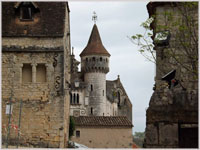 Rocamadour is a very small village in the Lot department in south western France. It rests in the gorge of the Alzou River, a tributary of the Dordogne. Rocamadour has a permanent population of roughly 600 but receives more than 1.5 million visitors a year from around the world.
Rocamadour is a very small village in the Lot department in south western France. It rests in the gorge of the Alzou River, a tributary of the Dordogne. Rocamadour has a permanent population of roughly 600 but receives more than 1.5 million visitors a year from around the world.
Rocamadour blends three distinct assets that make it such an inspiring place to spend some time at. Firstly, the initial spectacle of the town nestling against the side of a huge limestone cliff is one of enormous fascination and beauty. Secondly, Rocamadour supports surviving pre-medieval architecture. Some examples have their origins going back almost 1000 years and can be explored by all visitors. And thirdly, the village is closely associated with the primordial origins of French Christianity that continues to attract many pilgrims even today in the twenty first century.
Rocamadour is approached by travelling along some fairly narrow and tightly bent mountain roads. The first sight of the village is quite extraordinary. The timeless and ancient buildings seem almost pasted on to the steep face of a rocky cliff. Visitors will wonder why on earth everything was not eroded away by the ravages of time centuries ago. The village somehow creates a sense of mysterious permanence. It would be quite impossible to take out a mortgage on any of the street properties from a modern bank these days. Many of the buildings, however, are still there after hundreds of years.
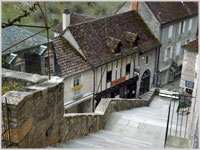 The arrival in the village towards its only prominent street, Rue de la Couronnerie, reinforces the idea of endurance. There are shops, restaurants, houses and hotels that seem to almost grow out of the limestone rock face. They seem completely protected and sheltered by the very existence of primeval natural structures.
The arrival in the village towards its only prominent street, Rue de la Couronnerie, reinforces the idea of endurance. There are shops, restaurants, houses and hotels that seem to almost grow out of the limestone rock face. They seem completely protected and sheltered by the very existence of primeval natural structures.
Rocamadour seems to have always been a natural shelter. History has it that an early Christian hermit called Zaccheus of Jericho made it his final home as early as the year 70AD. It is believed that he was the husband of St. Veronica who had wiped the face of Christ on the journey to Calvary. Some historians believe that Zaccheus had actually conversed with Jesus. It is thought by some that the village was named after him as a lover of rock, (roc amator).
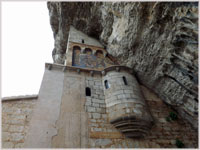 For Christian believers, a very sacred place in Rocamadour is called the Parvis of the Shrines. Tourists must wear sensible dress here for their visit. One of the ancient buildings in this square is called the Lady Chapel. In it is housed the statue of ‘The Black Virgin’. This is a roughly carved figure made from wood but presents very distinct and fresh facial features. The name comes from the black colour of the wood revealed beneath the badly worn paintwork. The sculpture is thought to come from the 12th century despite the expressive and recent appearance of the visage. A book was written in 1172 detailing 126 miracles associated with the carving. The presence of the wooden, sculptured Virgin makes Rocamadour a very holy place for pilgrims to visit. A number of the miracles involved the preservation of lives of imperilled French sailors at sea. A large carved sailing ship kept in the roof of the Lady Chapel commemorates this. A small iron bell, still in the chapel vault, is said to have rung of its own accord after these apparently miraculous events.
For Christian believers, a very sacred place in Rocamadour is called the Parvis of the Shrines. Tourists must wear sensible dress here for their visit. One of the ancient buildings in this square is called the Lady Chapel. In it is housed the statue of ‘The Black Virgin’. This is a roughly carved figure made from wood but presents very distinct and fresh facial features. The name comes from the black colour of the wood revealed beneath the badly worn paintwork. The sculpture is thought to come from the 12th century despite the expressive and recent appearance of the visage. A book was written in 1172 detailing 126 miracles associated with the carving. The presence of the wooden, sculptured Virgin makes Rocamadour a very holy place for pilgrims to visit. A number of the miracles involved the preservation of lives of imperilled French sailors at sea. A large carved sailing ship kept in the roof of the Lady Chapel commemorates this. A small iron bell, still in the chapel vault, is said to have rung of its own accord after these apparently miraculous events.
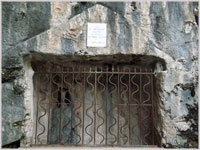 Amongst the Parvis structures rests the empty tomb of a Saint who has been called Rocamadour. In 1166, the finely preserved body of the Saint was discovered in a tomb resting by the threshold of the Lady Chapel. Some students believe that St. Rocamadour and Zaccheus may have been the same person. The history has become a little scrambled with the passage of time. The association of the ‘Black Virgin’ and the empty tomb make Rocamadour a place of international pilgrimage. The curiously conserved body of St. Rocamadour was destroyed during the Hundred Years war by the English. His empty tomb is maintained for visitors to view close by to its original location.
Amongst the Parvis structures rests the empty tomb of a Saint who has been called Rocamadour. In 1166, the finely preserved body of the Saint was discovered in a tomb resting by the threshold of the Lady Chapel. Some students believe that St. Rocamadour and Zaccheus may have been the same person. The history has become a little scrambled with the passage of time. The association of the ‘Black Virgin’ and the empty tomb make Rocamadour a place of international pilgrimage. The curiously conserved body of St. Rocamadour was destroyed during the Hundred Years war by the English. His empty tomb is maintained for visitors to view close by to its original location.
At the far end of the main street, there are 216 steps rising up to the Shrine of Our Lady in the Chapel. Over the past centuries and also sometimes today, pilgrims travel on their knees as they advance along these stairs. They stop off at each one and recite prayers using their rosary beads. Rocamadour is regarded by many as a place of healing rather like Lourdes, the famous city much further to the south. Rocamadour is one of a number of French locations that has always been associated with miracles.
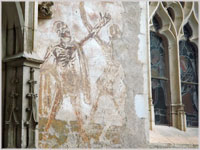 Two outside walls, close to the Chapel, support some of France’s earliest known external paintings. The most interesting is one of two skeletons armed with javelins. They represent a moral tale from the 15thcentury concerning the Three Living and the Three Dead. Time and the weather are slowly eroding away the paint but they remain plainly visible.
Two outside walls, close to the Chapel, support some of France’s earliest known external paintings. The most interesting is one of two skeletons armed with javelins. They represent a moral tale from the 15thcentury concerning the Three Living and the Three Dead. Time and the weather are slowly eroding away the paint but they remain plainly visible.
Rocamadour presents so many ancient buildings to visit that reflect the Christian origins of the village. The houses in the main street have been built over earlier medieval constructions but a number of features from much earlier times remain. The hospital gate is the remains of an archaic emporium that provided treatment and comfort to pilgrims who had travelled long journeys to find the settlement. Further into Rocamadour, visitors will pass through two entrance gates. The first is the Porte du Figuier where the main street begins. La Porte Salmon lies at the other end of Rue de la Couronnerie. Beyond that, the pilgrim steps up to the Palais Abbatatial and the Shrines begin. A few of the much earlier pilgrims were censored criminals from the courts. They were chained at their necks and their feet. Their progress was hard going ascending the steps, but on arrival at the Shrine, they were blessed by a priest and released.
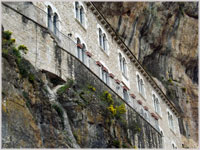 The palace houses many Christian features including priceless stained glass windows, works of medieval art and carvings. It is occupied by nuns living in a convent and their order is very strict. To become a member of this nunnery today would require the most sophisticated commitment. The nuns run their lives amongst, but separate from, the cosmopolitan collection of tourists that fill the village all year round.
The palace houses many Christian features including priceless stained glass windows, works of medieval art and carvings. It is occupied by nuns living in a convent and their order is very strict. To become a member of this nunnery today would require the most sophisticated commitment. The nuns run their lives amongst, but separate from, the cosmopolitan collection of tourists that fill the village all year round.
Attached to the palace, as you pass through it, is the Saviour Basilica. You can leave this via a tunnel and then pass through a further arch, the St. Martel Gate, leading to a track climbing up to the ‘Chateau Remparts’. This chateau was built to provide protection from hostile attack from the plateaux just above. It is surrounded by robust walls and rampart fortifications. Observation from these ramparts provides a most splendid sight of the Alzou River and a panoramic view of the village lying beneath. There is so much to see and visit in Rocamadour for visitors who are interested in the origins of Christianity and early French architecture. The atmosphere in the village is peaceful, solemn and sophisticated.
Back in the main street, life is more familiar. There are a number of high quality hotels and restaurants for visitors to use. The style of service is elegant everywhere and serves as a reminder of a more recognisable and routinely modern lifestyle.
Join all the tourists if you are staying in that region and gaze at the strangely spiritual endurance of Rocamadour. The village is immersed in long held values that have been respected by French people for many centuries.
For more information visit www.vallee-dordogne-rocamadour.com











